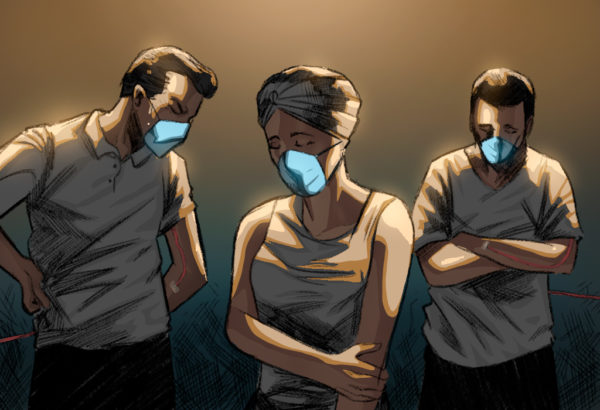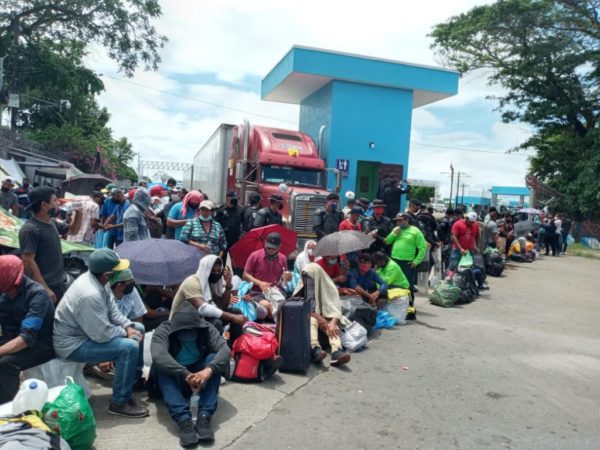Reviewing the Year of the Pandemic in Nicaragua

The Ortega regime politicized the Covid-19 public health crisis. They consistently refuse to provide trustworthy and verifiable information.
By Cinthya Torrez / Keyling T. Romero (Confidencial)
HAVANA TIMES – The year 2020 was marked above all by Covid-19. It became one of those years that will forever mark a before and after, all over the world. Some 80 million Covid infections have now been documented worldwide, and 1.7 million deaths. In Nicaragua, we don’t know the pandemic’s true impact, since the epidemic has been marked by the government’s lack of transparency.
The Ortega regime has also politicized the public health crisis. In Nicaragua, now a de facto police state, the effects of Covid have intensified the sociopolitical and economic calamity. This crisis, now in its third year, began in April 2018, with the killing and repression of citizen protesters.
Over 8,450 probable deaths from Covid
In ten months of the pandemic, 8,454 people have died, very probably from Covid-19. The government only admits 163 deaths, although the veracity of their reports is highly questioned. Early in May, when the curve of contagion first began to rise, officials denied the existence of a pandemic. Meanwhile, “express burials”, hastily conducted at late hours of the night or early hours of the morning, became common.
Public health expert Carlos Hernandez, of the independent “Multi-disciplinary Scientific Committee”, attributes over 7,500 deaths to Covid-19. He arrived at this statistic after analyzing the mortality rates that the Ministry of Health (Minsa) releases yearly. Hernandez counted the deaths ascribed to pneumonia, diabetes, hypertension and heart attacks, and compared those numbers with the year before.
In most cases, doctors were not allowed to list Covid-19 as the cause of death. Diagnostic tests for the disease are strictly centralized at the Minsa laboratory in Managua, and test results are not released. This has all formed part of the government’s strategy of minimizing the pandemic.
In December, the Nicaraguan Foundation for Economic and Social Development, an independent think tank, elevated the suspected death toll to 8,454. They included other certified causes of death that increased exponentially in 2020. The government denies that these deaths were due to Covid-19, and simply justifies them as “co-morbidity”.

Physicians lack protection
Over 830 Nicaraguan health workers have been infected with Covid-19, and 111 of them have died. This includes doctors and nursing staff, plus administrative, cleaning and logistics personnel at hospitals and health centers. These were the findings of the independent monitoring organization “Covid-19 Citizens’ Observatory”.
The government, however, limited its recognition to a general mention of the deceased during an event honoring the military’s medical teams. They’ve remained silent about their actions during the initial weeks of the pandemic. At the onset of the epidemic, health workers in the public facilities were forbidden to use face masks. This was supposedly “to avoid alarming the population”. Sixteen doctors were fired at that time, for supporting the call from over 500 specialists for a voluntary national lockdown. The same call included demands for protective equipment for those on the frontlines of defense against the pandemic.
Strict government secrecy
The little that is known of the government’s response to Covid-19 was leaked, to defy the official secrecy. The regime has offered no detailed or verifiable statistics regarding contagions, deaths, or the number of tests performed.
Minsa also established a system of additions and subtractions to inform about cases. This jockeying has kept anyone from knowing the exact number of recovered, infected, and hospitalized patients, or those undergoing follow-up. Official reports, backed by incomplete and capricious data, have remained far below those of independent monitoring organizations.
The Pan-American Health Organization (PAHO) questioned Nicaragua’s lack of data. They urged the country to supply more information, so that PAHO could evaluate the situation of the pandemic in Nicaragua.
Minsa also introduced patient descriptors like “delicate but stable”, “delicate and under care” and “in responsible and careful follow-up”. At one point, official weekly reports of the pandemic’s advance were suddenly suspended without explanation.
All tests centralized
For all ten months of the pandemic, Minsa has centralized the acquisition, processing and results of the Covid-19 tests. They’ve never offered complete information on the number of tests acquired and implemented, or on the results. Tests are processed only at the National Center for Diagnostics and Referral in Managua. For people needed a test to travel a cost of US $150 was imposed.
In contrast, other Central American countries have certified some 200 private laboratories to do testing. Nicaraguan labs have the capability to process tests, doctors and specialists state, but there’s no official will to decentralize.

Since Minsa has centralized all tests, they publish the data as they choose. They’ve hidden the results of some 6,200 positive cases. This was the conclusion after test data from March 18th and July 24, 2020 was leaked, supposedly by the “Anonymous” group.
Nicaragua is the only Central American country that hasn’t disclosed to PAHO the number of tests performed and processed. Ciro Ugarte, PAHO’s Health Emergency director, has repeatedly requested they supply this information.
Community spread
Seven months ago, PAHO warned that community spread of Covid-19 had already begun in Nicaragua. Today, the government continues to deny that they long ago lost the epidemiological trail of the novel Coronavirus. The disease has reached the rural communities and continues to circulate among the population. Nonetheless, the government has continued promoting mass activities, in which not even Minsa personnel use protective measures.
In March, four days before the country’s first official case was reported, they held a walk called “Love in the time of Coronavirus”. Over the next few months, Vice President Rosario Murillo promoted a series of fairs, festivals, sporting events and celebrations. There were estimates of over a thousand government sponsored activities in just one weekend in April.
Daniel Ortega mocked the “Stay home” campaign that civil society and independent medical associations were promoting at that time. “‘Staying home’ destroys the country,” he stated. “If we tell people, ‘Stay home’ – Who’ll fumigate?” the ruler asked ironically.
Independently organized efforts
Given the lack of official information regarding the pandemic, citizen initiatives like the Multi-disciplinary Scientific Committee were organized. This was a group made up of specialists in different medical fields. In addition to sharing scientifically grounded information, they’ve tried to explain the epidemiological behavior of Covid-19.
Another group that organized was the “Covid-19 Citizens’ Observatory”. This group, made up of public health experts, epidemiologists and a volunteer network, conducts independent monitoring of the pandemic’s impact.
For their part, the government justified their decision not to decree a lockdown by the need to protect the economy. However, they never took any official measures to protect workers in the informal sector. Nor did they offer any programs to reduce the pandemic’s impact on the economic sectors that were affected anyway.

Migrant crisis
The government also triggered a migrant crisis in mid-year when thousands of Nicaraguans became stranded while trying to return home. The pandemic had left these Nicaraguans unemployed in Costa Rica, Panama and on the Caribbean cruise ships. Hundreds began their return journey, using their last savings, or carrying only a suitcase. Without warning, the regime demanded that they show a negative test for Covid-19 to enter the country. In Nicaragua, that test can only be processed in Managua.
The requirement also affected the airline operations. As of December, only Avianca has resumed regular flights to Nicaragua.
At this juncture, the government claims that 74,390 Nicaraguans have returned to the country.
Distrust
Independent analyses of Nicaragua’s excess mortality show an average of 117 deaths for every 100,000 inhabitants. This would give Nicaragua the highest percentage of mortality in Central America. Doctors and specialists have explained some of the reasons for this elevated mortality rate.
Many patients only sought the hospitals during the final stages of the disease. Others preferred to die at home instead of going to the hospitals or health centers. There, not even the doctors have received adequate protective equipment. The patients also fear dying without being able to say goodbye to their loved ones.
Fear reigned in the country from April to June. Today, though, specialists warn that most citizens have relaxed their protective measures. Meanwhile, infections have begun to rise again, and there are fears of a second wave or surge.
Some numbers
Money received by the Nicaraguan government in terms of donations or loans to mitigate the pandemic: US $267.2 million dollars
This has been received from the World Bank, the International Monetary Fund, the Central American Bank for Economic Integration, the Taiwanese government, the Pan-American Health Organization and others. To date, the government hasn’t presented any accountability on the use of the funds.
The only “Covid contracts” reported between June and September were for $10 million dollars. The information was released as part of the regimes commitments, in order to have access to $185 million from the International Monetary Fund.
According to the World Health Organization, thirteen different vaccines have reached Phase III of development. Nicaragua will receive a certain percentage of vaccines free through the WHO. However, it’s still not known which vaccine they will receive, and the conditions needed to administer it. The regime has declared they’ll be given access to Russia’s “Sputnik V” vaccine. So far, though, they’ve offered no further details.





